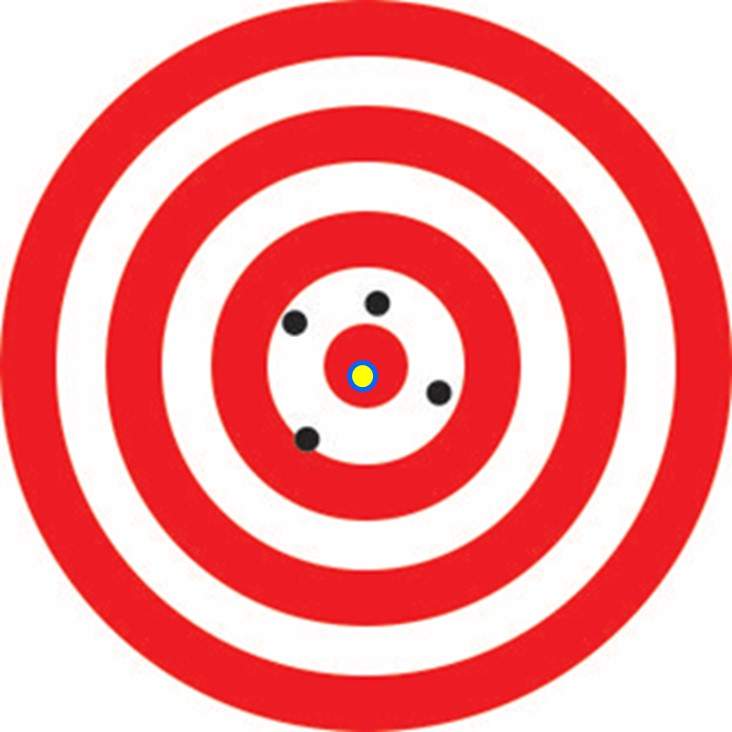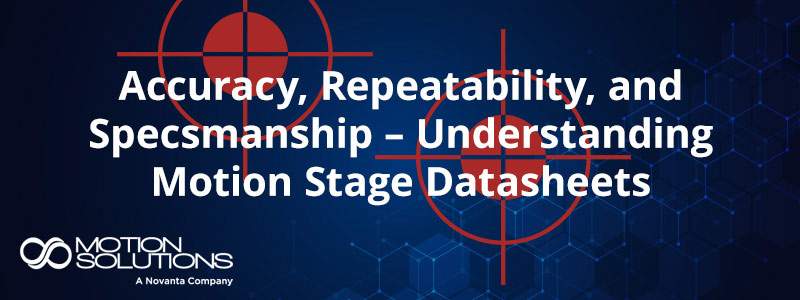[EDITOR’S NOTE: This blog post discusses accuracy and repeatability in the context of data sheets and product specification. For a detailed discussion of stage accuracy, repeatability, and resolution that covers definitions, nuances, and misconceptions, read our whitepaper here.]
In theory, a datasheet lists the capabilities and performance of a device, allowing it to be evaluated for suitability and compared with competing products. Unfortunately, when it comes to critical metrics like accuracy and repeatability, datasheets don’t always tell the full story. Here are some tips for decoding datasheet specifications to help ensure the product you choose will deliver the performance you need.
Accuracy
Accuracy is defined as the difference between the position commanded by the controller and the position of the load as measured by an independent instrument such as a laser interferometer. High accuracy is often required in metrology applications, where a load needs to be moved to a pre-defined exact location. The definition seems straightforward, but there are a number of nuances involved.
To clarify the accuracy specification on a datasheet, ask the following questions:
- Where was accuracy measured?
Motion stages are mechanical systems, and as such are affected by machining errors, mounting errors, encoder error, etc. As a result, accuracy varies across the length of travel of the stage. Ask whether the number specified for accuracy is measured at a single point or multiple points along full travel of the stage. - How was accuracy calculated?
There are multiple approaches to determining accuracy. Some manufacturers use statistical methods such as RMS or 3 Sigma. The problem is that taking the mean of multiple scattered measurements can result in a very high calculated accuracy for the datasheet, but that number won’t necessarily represent the performance of the actual stage (see Figure 1). At Motion Solutions, we follow ISO 230-2:2006, expressing accuracy on our datasheets as the maximum error plus a safety factor rather than as the mean of multiple measurements.

Figure 1: Determining accuracy by calculating the mean (yellow dot) of multiple measurements (black dots) can result in a number that does not reflect stage performance.
Repeatability
Repeatability quantifies the ability of a stage to return to a commanded position again and again. It’s a crucial metric for applications that need to take place at the same position. For example, a cell sorting system needs to move a single cell to a pre-determined sorted position, then return to look at that same cell at a later time.
Measuring repeatability begins with moving the load to an established zero position, then iterating back and forth through a set of pre-defined points across the full travel of the system. At each point, an actual position is recorded for each iteration and compared to the commanded position. Measurement points are often selected for specific reasons. In the case of a screw driven system, for example, these points should land on half rotations of the screw to make sure the full error of the screw is captured (measuring on full rotations, i.e. every 10mm on a 1mm screw pitch, ignores potential error sources).
Repeatability specifications can be unidirectional or bidirectional, calculated as follows:
• Unidirectional repeatability – the deviation of the measurements in a single direction
• Bidirectional repeatability – the deviation among all points in both data sets
What to ask about repeatability specifications:
- Does the repeatability number represent unidirectional repeatability or bidirectional repeatability?
Motion stages typically have better unidirectional repeatability than bidirectional repeatability. If the datasheet does not specify the type of repeatability, ask. If your application is bidirectional, you will want to know the source of the repeatability data to ensure that the stage will meet your requirements. Motion Solutions data sheets only report bidirectional repeatability. - How many measurements were taken to determine the final value?
Data taken over only a handful of points across limited travel can’t properly characterize stage repeatability. Stage performance must be measured at a high number of target points (ISO 230-2 requires 20 points, plus the home position) and over the full range of travel.
When “Typical” Values Aren’t Typical
As a final tip, the words “typical value” on a datasheet may not mean what you think. The accuracy and repeatability of a motion stage can be affected by mounting and installation, as well as environmental factors like vibration and thermal variation. Given time and resources, an expert test engineer might very well coax nanoscale performance from a screw-type stage, but only after a three-day thermal soak, sophisticated input filtering and algorithmic correction, and 3 AM data acquisition to avoid the effects of vibration introduced by trucks driving nearby.
Don’t assume that “typical” means that you can expect datasheet performance from your system simply because you follow mounting instructions. In some cases, typical value may be a variation on the fuel efficiency disclaimers found on automobile stickers – results from a controlled test, your mileage may vary. When you read the words typical value on a datasheet, talk to your vendor to learn what you can expect once their stage is installed in your product. Also, it’s entirely appropriate to ask them to share their raw data.
At Motion Solutions, our test engineers characterize our stages under standard installation and operating conditions – no three-day thermal soaks, no fancy filtering. Our specifications are based on the results of multiple stages pulled from stock, so they really are typical. Finally, we routinely share our raw data with customers so that they can truly understand the testing procedure and source of the results. This combination lets our customers be confident that the stage they choose will perform as advertised.
Datasheets are indispensable engineering tools, but you have to make sure you understand what the numbers mean. Don’t be afraid to ask questions. Your vendor should be prepared to answer them.
The Motion Solutions philosophy is to make datasheets as transparent as possible. Reach out to our expert team of sales and application engineers at [email protected]. We’re happy to help you select the ideal stage for your application.
Further Reading
A Cost-Conscious Approach to Boosting Accuracy in Screw-Driven Stages
Clearing Up Some of the Misconceptions Around Accuracy, Repeatability, and Resolution
About the Author
Matt Luxton, Product Specialist for Precision Motion




